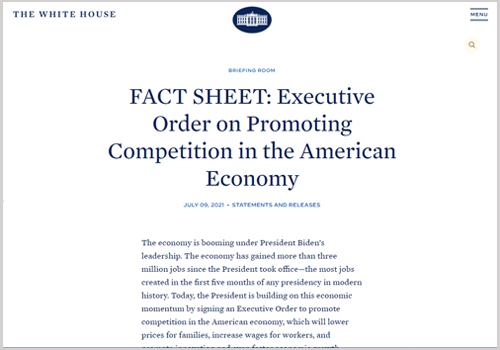Postcards From the Drug Pricing Trail
By Clive Riddle, July 16, 2021
President Biden’s recently released Executive Order on Promoting Competition in the American Economy included provisions regarding prescription drugs, first stating that “Americans pay more than 2.5 times as much for the same prescription drugs as peer countries, and sometimes much more. Price increases continue to far surpass inflation," and that "these high prices are in part the result of lack of competition among drug manufacturers."

The Executive Order:
- Directs the Food and Drug Administration to work with states and tribes to safely import prescription drugs from Canada, pursuant to the Medicare Modernization Act of 2003.
- Directs the Health and Human Services Administration (HHS) to increase support for generic and biosimilar drugs, which provide low-cost options for patients.
- Directs HHS to issue a comprehensive plan within 45 days to combat high prescription drug prices and price gouging.
- Encourages the FTC to ban “pay for delay” and similar agreements by rule.
With respect to drug pricing, its interesting that three days before the Executive Order was released, a USC study "comparing Medicare Part D prescription drug prices with those paid by Costco members finds that the federal government overpaid on roughly half of the most common generic medicines in 2018. The findings suggest that policymakers should take a closer look at the practices of intermediaries who effectively negotiate drug prices on behalf of Medicare but don’t necessarily pass on the savings to beneficiaries and taxpayers."
The study: Comparison of Spending on Common Generic Drugs by Medicare vs Costco Members, was published this month in Jama Internal Medicine, and found:
- Across more than 1.4 billion Medicare Part D claims for 184 products, Medicare plans overspent by 13% in 2017 and almost 21% in 2018 compared to Costco member prices.
- Medicare plans paid more than Costco members on almost 53% of 90-day fills analyzed in 2018. On all 30- and 90-day prescription fills, Medicare plans overpaid 43% of the time.
On the front lines of the drug-pricing front, GoodRx tracks the manufacturer drug price hikes that happen every year in January and July, and recently published their update on July 2021 Drug Price Increases. They noted that “last July, 67 drugs increased in price by an average of 3.1%, compared to 2019, when 37 brand drugs increased by an average of 4.3%.” So far this July, they have tracked 64 brand drugs increasing an average of 3.5%; 1 generic drugs increasing 0.3%, for an overall total of 65 drugs increasing an average of 3.5%. Topping the price increase list was Zolpimimist from Aytu BioPharma at 15.9%.
For perspective on individual drug costs from a volume standpoint, the ClinCalcDrugStats Datbase listing of the top 200 drugs of 2021 by volume is headed by Atorvastatin (cholesterol) which had 112.5 million U.S. prescriptions in 2018, at an average total drug cost of $50.97 per prescription ($1.00 per day of therapy) with covered patients paying an average $7.32 in cost-sharing. Number two was Levothyroxine (thyroid) which had 105.8 million U.S. prescriptions in 2018, at an average total drug cost of $25.14 per prescription ($0.50 per day of therapy) with covered patients paying an average $12.50 in cost-sharing.
But the high volume prescription costs haven’t been the chief driver of overall cost increases for some time. The oft-cited culprit are specialty drugs. One report, released last month: the AMS 2020 Specialty Drug Trends Report, found that:
- Fewer than 2% of the U.S. population utilized specialty drugs
- Specialty drugs account for more than half (51%) of total drug spend
- 80% of annual medical trend increases were driven by specialty drug costs
- The top 10 Medicare Part B covered drugs accounted for 2% of all covered products but 43% of total Part B drug spending
 Post a Comment By
Post a Comment By  Riddle, Clive |
Riddle, Clive |  Friday, July 16, 2021 at 09:30AM tagged
Friday, July 16, 2021 at 09:30AM tagged  Innovation|
Innovation|  Reform & Regulatory
Reform & Regulatory 

Reader Comments